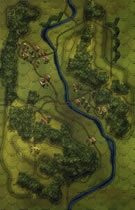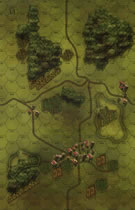|
Obsession Junction Black SS #31 |
||
|---|---|---|
| (Defender) Germany | vs | United States (Attacker) |
| Formations Involved | ||
|---|---|---|
| Germany |  |
1st SS "Leibstandarte Adolf Hitler" Division |
| Germany |  |
2nd SS "Das Reich" Division |
| United States |  |
30th "Old Hickory" Infantry Division |
| United States |  |
3rd "Spearhead" Armored Division |

| Total | |
|---|---|
| Side 1 | 2 |
| Draw | 0 |
| Side 2 | 0 |
| Overall Rating, 2 votes |
|---|
|
3.5
|
| Scenario Rank: --- of 913 |
| Parent Game | Black SS |
|---|---|
| Historicity | Historical |
| Date | 1944-08-10 |
| Start Time | 14:00 |
| Turn Count | 12 |
| Visibility | Day |
| Counters | 58 |
| Net Morale | 0 |
| Net Initiative | 1 |
| Maps | 1: 29, 31 |
| Layout Dimensions | 43 x 28 cm 17 x 11 in |
| Play Bounty | 137 |
| AAR Bounty | 171 |
| Total Plays | 2 |
| Total AARs | 1 |
| Battle Types |
|---|
| Road Control |
| Urban Assault |
| Conditions |
|---|
| Off-board Artillery |
| Reinforcements |
| Terrain Mods |
| Scenario Requirements & Playability | |
|---|---|
| Black SS | Base Game |
| Cassino '44 | Counters |
| Elsenborn Ridge | Counters |
| Fall of France 1 | Maps |
| Introduction |
|---|
|
Each side had dug in it heels at RJ278, and it had become a matter of pride to control it. The Germans had stopped trying to overwhelm the roadblock at L'Abbaye Blanche to the south and did not send any reinforcements to Kampfgruppe Ullrich so that RJ278 could remain well-defended. For their part, the Americans had worked all day to bring up enough armor support to insure that they controlled RJ278 at sundown. |
| Conclusion |
|---|
|
The Americans steadily advanced until an antitank gun destroyed their dozer tank. The fighting then seesawed until a small battle group from the SS Lifeguard hit the American left flank. the Americans fell back with the Germans declining to follow. |
| Additional Notes |
|---|
|
Playable without using the black SS counters. |
| AFV Rules Pertaining to this Scenario's Order of Battle |
|---|
|
| 2 Errata Items | |
|---|---|

|
All SPW 251s have an armor value of 0. (Shad
on 2010 Dec 15)
|

|
The reduced direct fire value of the SS HMG is 5-5 in Beyond Normandy and Road to Berlin. (plloyd1010
on 2015 Jul 31)
|
| Obsession Junction | ||||||||||||
|---|---|---|---|---|---|---|---|---|---|---|---|---|
So the game ended with the US holding one of the three required victory hexes and hence this was a German victory. This scenario was very exciting albeit that the German player for the most part simply tried to defend in the town assault hexes; the assault on the crossroads hex was, as might be expected, more back-and-forth. Although the US had armor in the town assault, the German player thought that risk of the negative col shifts for attacking in a town outweighed the possible AT shot and hence only defended. The German player was faced early on with a risk-reward choice for the PzIVF2 and the AT gun. The die rolls went back and forth: the US player had a hot streak early on morale checks, but a poor run on AT rolls, allowing the PzIVF2 to get in a few more kills. The middle few turns were somewhat phlegmatic in terms of die rolls with nothing dramatic occurring. Once the panther and 3xGREN reinforcements arrived, however, US rolling became insane and what appeared to be a mopping up by the SS turned into near panic. Only some stronger rolling on the last two turns by the Germans and weaker rolls by the US kept RJ 278 in German hands. From the perspective then of drama and the "thrill of victory/agony of defeat" that comes with the vagaries of die-rolling, this scenario was quite a success and had a couple of dramatic changes of fortune. It was doubtful whether the US could ever have taken the second (northern) town hex (and hence a victory in game terms), but the players essentially turned the battle down the stretch into a contest for a moral victory regarding the two assaults on the road junction and the southern town hex. Had the SS leaders not been quite so strong, but all else been equal, the US might well have been difficult to stop. Highly recommended, particularly for an aggressive and short scenario. |
||||||||||||
| 0 Comments |

 BlSS030
BlSS030 

























